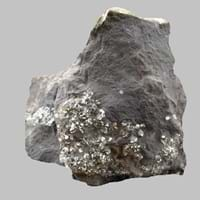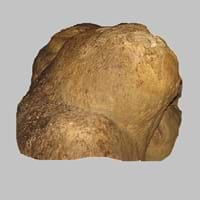Definition
Argillites are highly compact sedimentary or slightly metamorphosed rocks that consist largely or wholly of particles of clay or silt but lack the fissility of shale or the cleavage characteristic of slate
Travertine is a mineral consisting of layered calcium carbonate formed by deposition from spring waters
Discoverer
Unknown
Marcus Vitruvius Pollio
Etymology
From Latin Argilla (clay) and -ite in English which became agrilla+ -ite = Argillite
From Italian travertino a kind of building stone, from Tiburs, adjective from Tibur (Tivoli), in Italy
Class
Sedimentary Rocks
Sedimentary Rocks
Sub-Class
Durable Rock, Soft Rock
Durable Rock, Medium Hardness Rock
Group
Not Applicable
Not Applicable
Other Categories
Fine Grained Rock, Opaque Rock
Fine Grained Rock, Opaque Rock
Texture
Clastic, Polished
Banded
Color
Dark Grey to Black, Pink, Red, White
Beige, Black, Blue, Brown, Grey, Red, White, Yellow
Durability
Durable
Durable
Scratch Resistant
Yes
Yes
Appearance
Rough and Dull
Fibrous
Interior Uses
Decorative Aggregates, Homes, Interior Decoration
Decorative Aggregates, Entryways, Flooring, Homes, Interior Decoration
Exterior Uses
As Building Stone, Garden Decoration, Office Buildings
As Building Stone, As Facing Stone, Paving Stone, Garden Decoration, Office Buildings
Other Architectural Uses
Curbing, Whetstones
Curbing
Construction Industry
Used for flooring, stair treads, borders and window sills.
As Dimension Stone, Building houses or walls, Cement Manufacture, Construction Aggregate, for Road Aggregate, Raw material for the manufacture of mortar
Medical Industry
Not Yet Used
Not Yet Used
Antiquity Uses
Artifacts, Monuments, Sculpture
Artifacts, Jewellery, Monuments, Sculpture, Small Figurines
Commercial Uses
Fire resistant, Used to manufracture paperweights and bookends
Cemetery Markers, Creating Artwork, Gemstone, Jewelry, Paper Industry, Pottery
Types
Not Available
Not Available
Features
Is one of the oldest rock
Stalactites and stalagmites are formed from this rock, Surfaces are often shiny, Very fine grained rock
Archaeological Significance
Famous Monuments
Data Not Available
Colosseum in Rome, Italy, Sacré Coeur in Paris, France, Trevi Fountain in Rome, Italy
Famous Sculptures
Data Not Available
Data Not Available
Formation
An argillite is a fine-grained sedimentary rock mainly composed of clay particles which forms from lithified muds which contain variable amounts of silt-sized particles.
Travertine is a type of sedimentary rock formed when a river carries or transports pieces of broken rock which then undergo sedimentation. They are then subjected to high temperature and pressure hence forming travertine rock.
Mineral Content
Biotite, Chlorite, Feldspar, Micas, Muscovite or Illite, Plagioclase, Pyrite, Quartz
Calcite, Clay, Feldspar, Micas, Quartz
Compound Content
Iron(III) Oxide, Potassium Oxide, MgO, Silicon Dioxide
Ca, NaCl, CaO, Oxygen
Types of Metamorphism
Not Applicable
Not Applicable
Types of Weathering
Biological Weathering
Biological Weathering, Chemical Weathering, Mechanical Weathering
Types of Erosion
Chemical Erosion
Chemical Erosion, Coastal Erosion, Glacier Erosion
Grain Size
Fine Grained
Fine Grained
Fracture
Conchoidal to Uneven
Splintery
Streak
White to Grey
White
Porosity
Highly Porous
Highly Porous
Luster
Waxy and Dull
Dull to Pearly
Compressive Strength
Not Available
Cleavage
Slaty
Non-Existent
Specific Gravity
2.56-2.68
1.68
Transparency
Opaque
Opaque
Density
2.54-2.66 g/cm3
2.71 g/cm3
Resistance
Heat Resistant, Impact Resistant
Impact Resistant, Pressure Resistant, Wear Resistant
Deposits in Eastern Continents
Asia
Bangladesh, China, India, Russia
China, Russia
Africa
Ethiopia, Kenya, Morocco, South Africa, Tanzania
Not Yet Found
Europe
Austria, France, Germany, Greece, Italy, Romania, Scotland, Spain, Switzerland
Austria, Italy, Portugal, United Kingdom
Others
Not Yet Found
Not Yet Found
Deposits in Western Continents
North America
USA
Canada, USA
South America
Bolivia, Chile, Colombia, Ecuador, Peru, Venezuela
Argentina, Bolivia, Ecuador
Deposits in Oceania Continent
Australia
New South Wales, New Zealand, Queensland, Victoria, Western Australia
Not Yet Found
All about Argillite and Travertine Properties
Know all about Argillite and Travertine properties here. All properties of rocks are important as they define the type of rock and its application. Argillite and Travertine belong to Sedimentary Rocks.Texture of Argillite is Clastic, Polished whereas that of Travertine is Banded. Argillite appears Rough and Dull and Travertine appears Fibrous. The luster of Argillite is waxy and dull while that of Travertine is dull to pearly. Argillite is available in dark grey to black, pink, red, white colors whereas Travertine is available in beige, black, blue, brown, grey, red, white, yellow colors. The commercial uses of Argillite are fire resistant, used to manufracture paperweights and bookends and that of Travertine are cemetery markers, creating artwork, gemstone, jewelry, paper industry, pottery.










